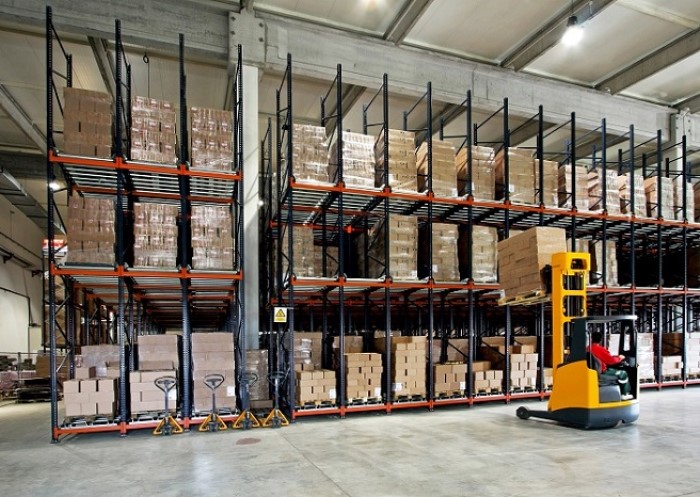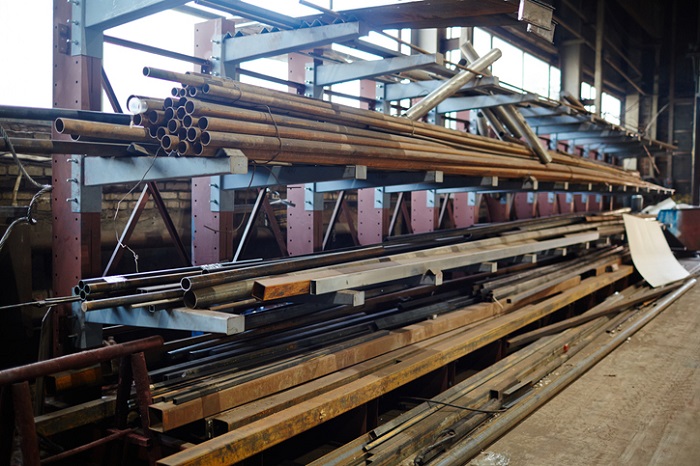Table of contents
Depending on its design, industrial heavy-duty shelving must be able to safely store shelf loads of up to 4,000 kg and are therefore subject to load testing. When assembling a heavy-duty rack, such as a wide-span or pallet rack, it is therefore important to mount the rack in for optimal stability. This applies especially to environments in which forklift trucks or people are moving through the racking aisles.
Heavy-duty metal shelving can be designed as plug-in racks, where the individual components are plugged together. The plug-in system is often used for shelf racks. Heavy-duty storage racks with a bolt system, on the other hand, are assembled with bolted connections. These include, for example, wide-span racks, which can accommodate storage goods with large dimensions. Cantilever racks, which are ideal for storing long timbers or pipes, are also assembled with bolts.
Below, we explain how to assemble the different types of heavy-duty shelving and what you need to consider for reach type.
Checking and preparing the floor
In order for heavy-duty shelving to have a solid foundation under a full load, a level and solid subfloor is a prerequisite. Before assembling heavy-duty racks, you should therefore check the subfloor for slopes, damage, or unevenness. You can compensate for this with appropriate floor plates or coverings. In addition, the floor should also be suitable for the planned load weight and be correspondingly resistant.
Assembling heavy duty storage shelves – planning the necessary aids
Depending on the assembly system, various tools and aids are required to build heavy-duty shelving. These should be ready at the start of assembly. In the respective assembly instructions for the heavy-duty rack, you will find useful information on this. Nevertheless, it can be advantageous to have additional tools at hand. These include, among others:
- Hammer (wooden or rubber), which is used to assemble the parts of a connector.
- Screwdrivers and wrenches in the required sizes.
- Tension straps or screw clamps to temporarily fix the shelves.
- Drill screwdriver for fixing the heavy-duty shelving to the wall.
- Anti-slip mats for a working area during assembly.
For safety reasons, you should also assemble the heavy-duty rack together with at least one other person. Depending on the size of the rack and the weight of the components, you should even consider several assistants.
Bolted or plug-in connections – observe assembly instructions
Heavy-duty racks using a plug-in system, such as some shelf racks, are assembled using simple snap-in connections and can optionally be secured with screw connections. The respective assembly instructions will give you specific instructions on the sequence in which the uprights and shelves must be connected to each other. Follow these exactly so that all components can completely snap into each other and the shelf stands securely and stably.
The same applies, of course, to heavy-duty shelving that is assembled using the bolt system. In addition, make sure that all accessories included in the assembly set, such as washers or markings for the maximum load, are completely installed. Also, only exactly those screws or accessories should be used that are listed in the assembly instructions and are suitable for the heavy-duty rack. This is the only way to ensure that the racking meets all safety requirements.
Cantilever or wide span shelving also often requires a tight bolted connection to the floor or wall. Here, the following applies: If the rack dimensions reach a height-to-depth ratio of ≥ 5:1, it is mandatory to secure them from tipping over by using some form of anchoring. In the case of pallet racks, the anchoring requirement applies irrespective of the rack dimensions.
Securing heavy-duty shelving from tipping over
Check the assembly or operating instructions for your heavy-duty shelving to see if it needs to be additionally secured against tipping over, as in certain conditions it is mandatory may also stipulate shelf fixing is necessary in the following cases:
- When the rack dimensions reach a height-to-depth ratio of ≥ 5:1 (the decisive factor is the top storage level)
- Any type of rack that is loaded using industrial trucks (e.g. pallet racks), regardless of the dimensions.
In order to adequately secure these heavy-duty storage racks, the load-bearing parts of the frame structure must be connected to or anchored in a suitable structural element — i.e. the floor or wall. Usually, fixing heavy shelves to plasterboard walls is not advised. For this purpose, heavy-duty screw-dowel connections are used. If you want to further stabilize the shelf, you can also connect adjacent shelves to each other.
Important accessories for heavy-duty shelving – storing large loads safely
When you assemble heavy-duty racking, additional accessories can be integrated to make everyday work in the warehouse or workshop easier and safer:
- Push-through guard or rear wall guard — This device prevents transport containers or pallets from being pushed through too far and falling when loading the rack on free-standing heavy-duty racks without a rear wall.
- Pallet pull-out device — This addition to heavy-duty shelving makes it easier to reach the contents of pallets without having to lift them out of the shelving each time they are removed.
- Deflector corners — These corners have a high signalling effect. They are available in angled or U-shaped profiles and can be equipped with deflector rollers that protect against collisions with industrial trucks. For pallet racks, deflector corners are mandatory.
- Impact protection — Especially when industrial trucks or lift trucks are moving within a warehouse, impact protection on the heavy-duty racks can provide more safety.
- Roll-off protection — Especially when storing movable unit loads such as pipes or small parts, roll-off protection can ensure that stored goods cannot fall out of the rack.
- Components with extension option — Heavy-duty racks can be enlarged if required and flexibly extended by utilizing add-on bays.
Erecting heavy-duty shelving – observing safety regulations
As soon as you erect heavy-duty shelving and use it commercially, corresponding safety regulations must be observed. Without these measures, heavy-duty shelving may not be used or must sometimes be retrofitted at great expense. Therefore, you should take care to comply with any safety regulations during the assembly.
This includes, among other things, ensuring compliance with the working aisle widths for forklifts and lift trucks when installing the shelving. The respective shelving units must also be visibly marked with the maximum load capacity per shelf so that employees do not overload the units. The safety specifications for heavy-duty shelving and the assembly instructions also contain information on how best to secure or fasten the respective type of shelving to prevent it from tipping over.
FAQ for heavy-duty shelving
Heavy-duty shelving can be loaded with shelf loads of up to 4,000 kg. Since this weight can multiply depending on the height and size of the rack, the surface must be suitably resistant so that it does not yield to the load. For a stable foundation and safe loading, it is mandatory that the side panels are perpendicular. Uneven floors must therefore be levelled out before the heavy-duty shelving is assembled.
There are heavy-duty racks with plug-in assembly as well as those that are assembled with screw connections. In warehouse logistics, a combination of both methods is often used due to the higher load capacity. In this case, the frame construction is firmly bolted, while the supports for the shelves are simply inserted into the frame.
There are numerous safety regulations dictated by the UK Governments Health & Safety Executive. Annual inspections are required in line with the Health & Safety at Work 1974 and Provision & Use of Work Equipment Regulations (PUWER) legislation. More information on both can be found here.
Please note: The regulations mentioned above represent only a selection of the most important legal requirements. Please refer to the listed organisations and directives for more detailed information. If in any doubt, consult experts or contact the relevant regulatory authorities.
Image source:
© gettyimages.de – Baloncici





